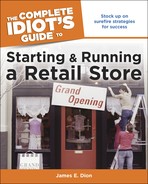Chapter 6
Define Your Vision and Determine Your Strategy
In This Chapter
• Concepts that worked
• Identifying your niche
• Realizing your vision
• Developing your strategies
Your idea for your retail store may be based on your passion or your expertise, or you may just think it’s a good concept. However, you must define the vision for your store and determine the strategies you will use to build your business. Your vision and resulting strategy will be the foundation and the glue that holds your business together.
In this chapter, I introduce three successful retailers who built their retail businesses based on their passion or expertise. They found their niches and built successful businesses based on those niches. After taking a brief look at what they did, I will take you through the steps of articulating your vision and determining your strategy.
How Some of the Most Creative Store Concepts Came to Life
Every successful store starts with a person’s, couple’s, family’s, or group of friends’ idea about what they think people want but don’t currently get in the existing retail environment. Three very successful retail businesses—Healthy Back, Build-A-Bear, and Crate & Barrel—all started with one small store in one community built around the visions of their founders. Let’s take a look at how each started.
Healthy Back
Anthony Mazlish founded Healthy Back in March of 1994 because he wasn’t able to find the products for relief from his own back problems. He became frustrated with the lack of options available. None of the existing products being offered helped to relieve his pain. He realized that the world needed a store that specializes in the sale of a variety of ergonomically designed products that help to relieve back and neck pain, and improve daily comfort.
The first Healthy Back store opened in Rockville, Maryland, in 1994 and exceeded all expectations. The first store’s success was so good that the company opened additional stores in the Washington, D.C., metropolitan area. The first prototype store for national expansion opened in Raleigh, NC in 1996. Healthy Back then acquired a back retailer based in San Diego in 1998 to continue its expansion. Today the company runs 17 stores, an online shopping store at www.healthyback.com, as well as a mail-order catalog.
Anthony Mazlish identified his niche while trying to solve his own problem—a problem that became his passion and helped him develop a successful retail business.
Build-A-Bear Workshop
Maxine Clark started Build-A-Bear after a 25-year career with May Department Stores. Her passion for retailing started when she was a girl growing up in Miami. When designing Build-A-Bear, she wanted to create a magical entertainment place for children with a carnival atmosphere. She started Build-A-Bear with $750,000 in personal savings and opened her first store in St. Louis, Missouri, in October 1997.
Maxine wanted to build an interactive entertainment retail experience. Each store is built around the teddy bear theme with original teddy bear fixtures and artwork. As children build their own bear (or other stuffed animals, such as frogs, bunnies, cows, dogs, cats, and ponies), store associates (known as Master Bear Builders) help the children (known as guests) throughout the bear-building process. Today the company operates over 190 Stores in the United States and Canada with revenue over $300 million. It is listed on the New York Stock Exchange as BBW.
Savvy Retailer
You can learn more about how Maxine Clark built her successful Build-A-Bear Workshop business by reading her book, The Bear Necessities of Business: Building a Company with Heart by Maxine Clark and Amy Joyner published by Wiley in 2006.
Maxine Clark used the expertise she learned working for others for 25 years, as well as her passion for building an interactive entertainment environment for children, to create a successful retail experience. But remember it all started with a lifelong vision and one store in St. Louis in 1997.
Crate & Barrel
Crate & Barrel was started by Gordon and Carole Segal in 1962 when they returned from their European honeymoon. While in Europe they bought all kinds of unique, functional, and affordable items for their home. When they got back to Chicago, they realized that no one was selling the great designs they found at reasonable prices in Europe. So the idea of Crate & Barrel was born.
Their first store was opened in an abandoned elevator factory because they couldn’t afford to lease anything else. The walls were old brick and they had no budget for drywall, so they nailed up crate lumber to cover them. They stacked shipping crates and filled barrels as display fixtures. Their lack of funds ended up creating the well-known retail environment that you find in their stores today. This environment created by financial necessity helped them to come up with a unique name for their stores, “Crate & Barrel.”
Their first store opened in December 1962 with one employee and the Segals operating the store. The store showcased affordable gourmet cookware and contemporary housewares that could not be found elsewhere in the United States. According to the history on Crate & Barrel’s website, the Segals were so excited about their new venture they forgot to buy a critical item—a cash register. So they used a box with a lid. Today Crate & Barrel operates 150 stores nationwide.
The Segals had little experience operating a retail business and started their store based on a product line that they knew was unique, but thought others would want.
They developed a retail environment that you can still find in their stores today that was built on necessity—they just didn’t have the money to do anything else.
Identify Your Passion or Your Expertise
So what is your passion? Do you believe your expertise is something around which you can build a successful store?
There is no way that I, or anyone else, can create a vision for your store. Your vision must come from you. You have almost total freedom to create your business as long as it is based on a service or product that the public needs.
What I can do is help you to clarify your vision and create the type of retail business you want to build. The best way to get started is to pretend that you are your store’s first customer on opening day. You are standing outside the new store that you have never seen before. Within a matter of seconds you will decide whether or not to enter that store.
Through the eyes of this customer, what do you see that makes you want to open the door and enter the store? What does the store look like? What do you see when you first enter the store? Take the time to develop your answers to these questions as you try to fine-tune your vision.
Picturing your business in your mind is a crucial process in which you literally close your eyes and spend hours seeing, hearing, touching, tasting, and smelling the business you are about to create.
Discover Your Secret Weapon
You also must find your secret weapon. That will be the hook that gets customers to come to your store rather than your competitors’. You should choose your secret weapon based on the needs of your customers.
Selling Points
Remember this important lesson from Marketing 101: customers do not need to buy drills to have them, they buy them so that they can make holes. You should not think about why customers want to buy a particular product, but you must think instead about how that product solves a particular need that the customer has.
For example, if you decide that your vision is to run an eyewear store, your secret weapon might be the fact that you are an artisan who can custom-design eyewear. Instead of just talking about “glasses,” you would talk to customers about “unique, hand-crafted frames that complement [their] unique personality.”
This statement appeals to both the apparent need, which is glasses, and to a deeper need, which is individuality—something that the store’s secret weapon can deliver effectively. Then you must ask whether there are enough customers who need both the glasses and individuality for this eyewear store to be successful. More to the point, the big question is: are there enough customers who need both your product and the deeper need that your secret weapon can deliver? In Chapter 3, I discuss how to evaluate your idea and customer base.
Can you identify the secret weapons for the three successful retailers just discussed? For Healthy Back the secret weapon was finding ergonomically designed products for the neck and back and selling an assortment of these products all in one place. For Build-A-Bear Workshop it was designing a unique interactive shopping experience for children of all ages. For Crate & Barrel it was offering European-style gourmet cookware and other obscure household items at an affordable price in a themed retail shopping experience.
As you develop your vision, visit successful retail stores around you and try to identify their secret weapons. As you begin to identify other secret weapons, you will find it easier to develop your own secret weapon and find your own niche. In Chapter 4, I discuss how you get to know your competition.
Articulate Your Vision
You need to think carefully about four critical questions as you try to articulate the vision for your store. Your ultimate success or failure could literally depend on you finding good answers.
• Why should a customer shop in your store?
• What is the role of price competitiveness in your store?
• What is the range of merchandise assortments in your store?
• What is the level of service in your store?
Use this worksheet to help you develop a clear vision for your store:
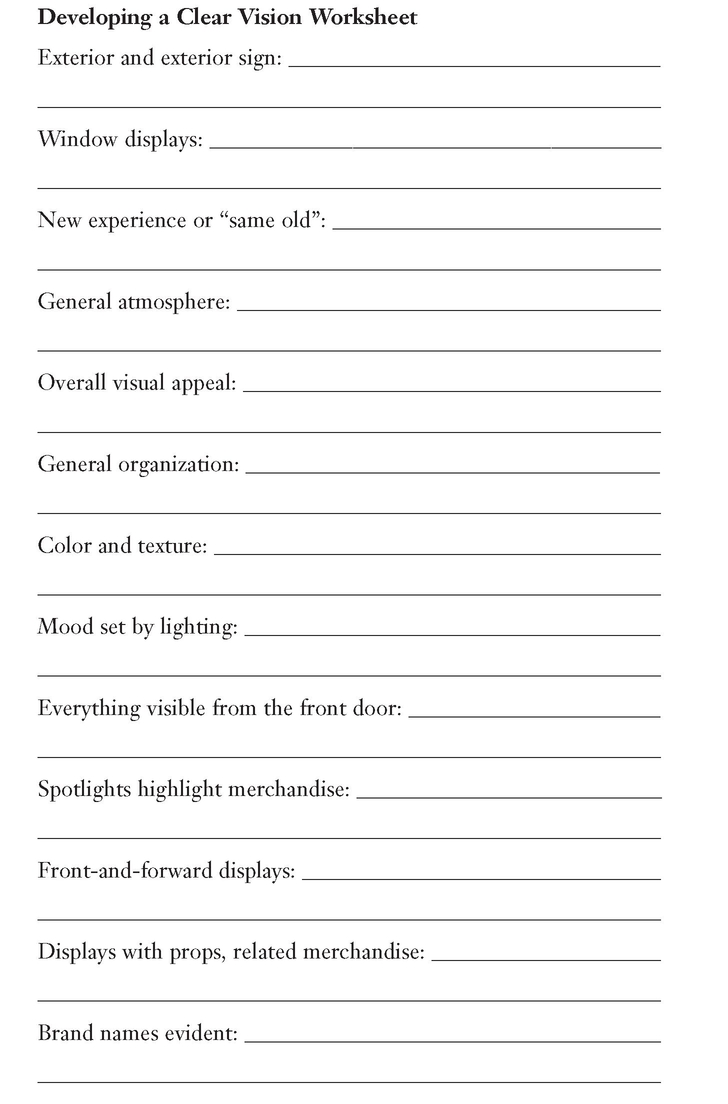
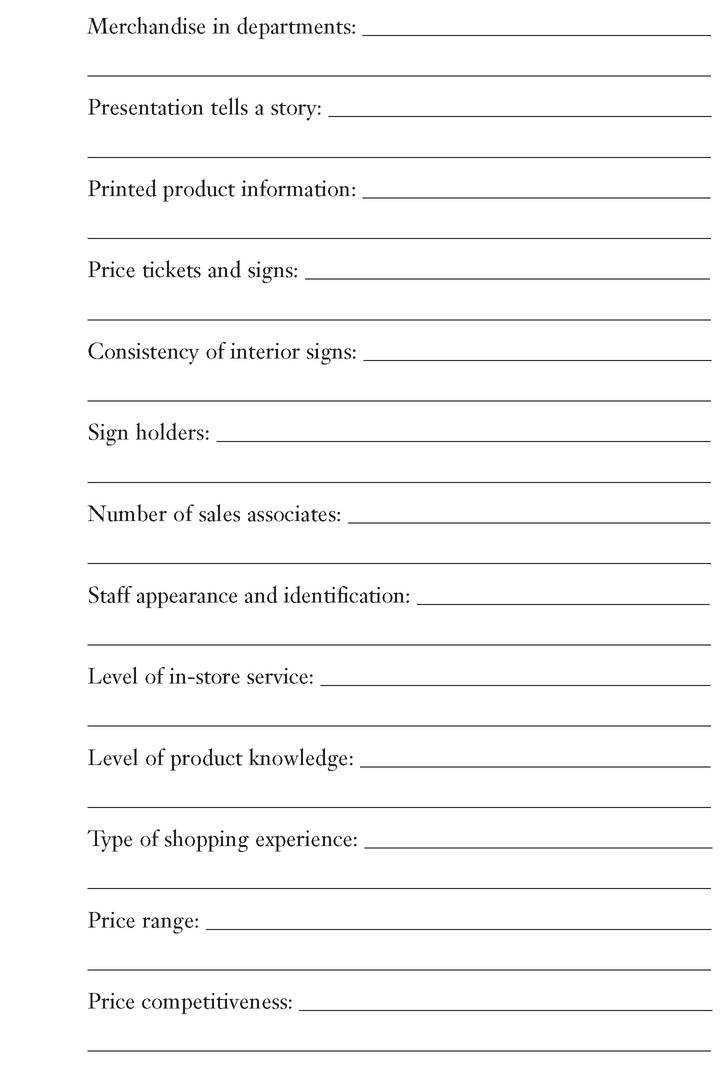
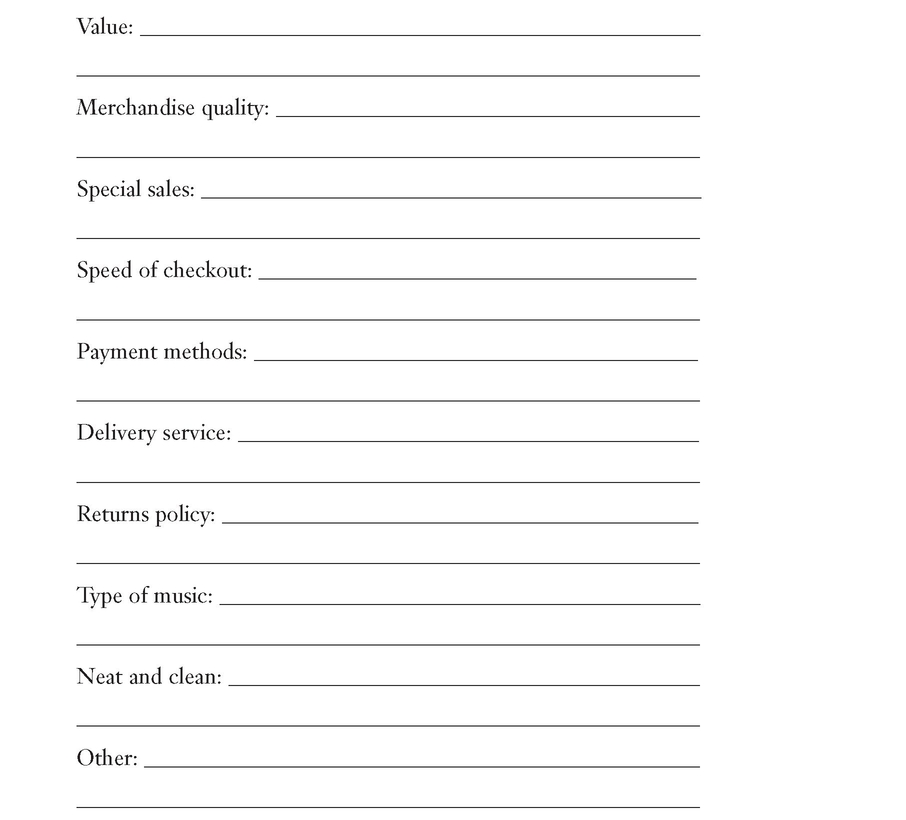
As you try to complete this worksheet, you may find that you are not able to fill in all these details. Come back to the worksheet after you’ve finished learning more details about running your store in Parts 4 and 5. You can then refine and expand your vision in Appendix C, which also has a copy of this worksheet.
Build Your Strategies
After you’ve articulated your vision, you will need to make some fundamental strategy decisions about where your retail business fits in the broad spectrum of retail alternatives that are available in your area. One key part of this decision-making process is your strategy for adding value to the products that manufacturers create.
To be successful, every retail business needs to add value to the products it sells by adopting one of three basic strategies:
• Offering the greatest or newest assortment of products
• Offering the lowest prices
• Offering the best or fastest service
Although these strategies add value, each one meets the needs of different customers. The challenge you face in retail is to be at least competitive in all three areas and to clearly exceed your customers’ expectations in one of them. In the following chart, I summarize the impact of these three strategies.
The greatest-assortment strategy involves “dominating” a product such as toys, office supplies, or furniture. To adopt the greatest-assortment strategy, a retailer must be among the largest in the country—able to purchase huge quantities and introduce efficiencies that the vast majority of retailers can only dream about. Another component of this strategy is to have the best “edited” assortment, one that your customers find perfect for them.
The lowest-price strategy involves economies of scale (buying cheap by ordering large quantities) and driving every possible cost out of the business. To adopt the lowest-price strategy, a retailer also must be among the largest in the country—able to purchase huge quantities and introduce efficiencies that the vast majority of retailers can only dream about.
In today’s retail world, the big-box retailers “own” these first two strategies. You would need a megastore of 100,000 square feet and millions of dollars in inventory just to play in their league. That is why they are sometimes called “Category Killers,” because they can kill a category for other retailers whether it is toys, electronics, or clothing.
With assortment and price taken, the only option left for you is the best-service strategy. Although this strategy comes to you by default, it can be very successful and profitable. Indeed, we believe that this is the future of owner-operated retail in North America—if you are prepared to “walk the walk” and make service the heart and soul of your business. The service strategy also can be found in convenience stores. Here the strategy is providing a service that is both fast and convenient.
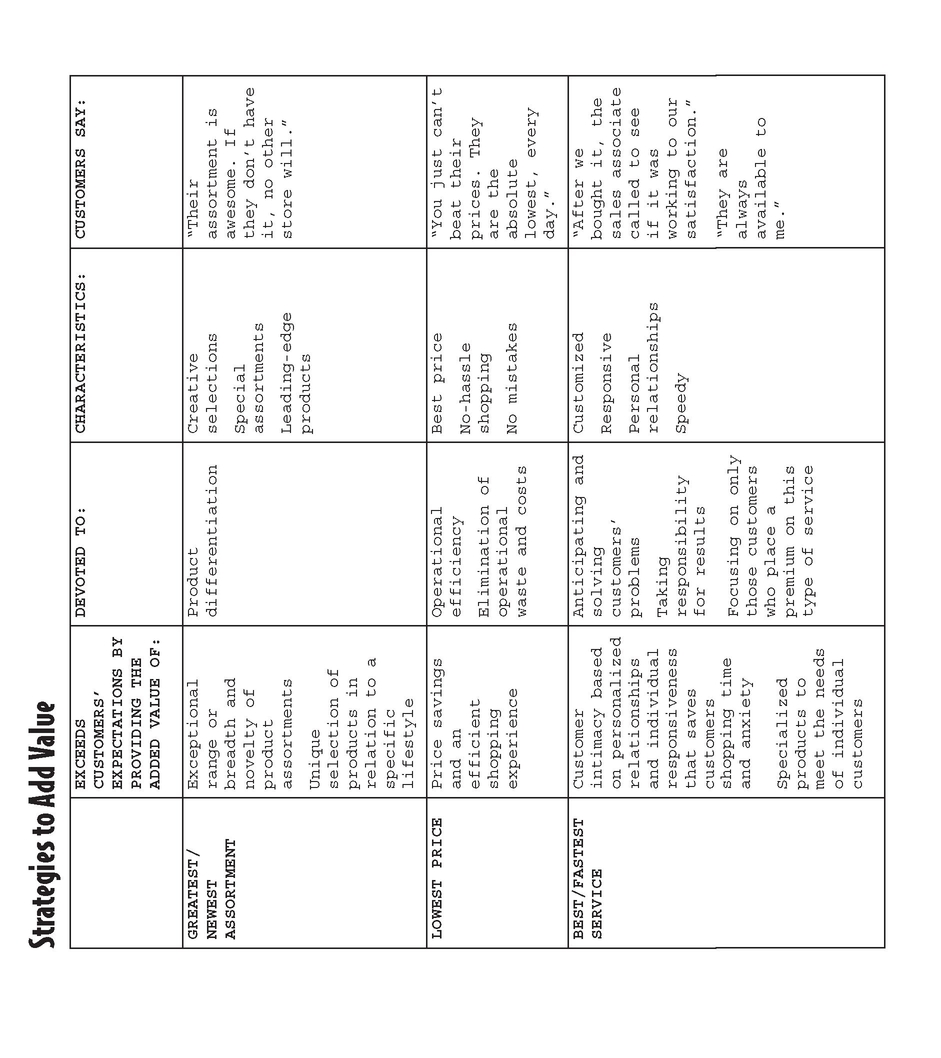
You may find it easy to answer the question, “Why should a customer shop in my store?” with great-sounding words but, as anyone who has ever tried to deliver good service knows, the “talk” is much easier than the “walk.” To start, you need to structure your business so that everything you do—and every strategy, merchandising, buying, personnel, sales management, technology, and customer service decision you make—is focused clearly on service.
We are not suggesting that you can ignore assortment and price as you start to develop a “strategic framework” for your business. To the contrary, you cannot have great service if you do not have what your customers want. You also won’t have many customers if you have what your customers want but your prices are 30 percent higher than the prices at your competition.
You need to think carefully about your range of merchandise assortments. As the buyer for your business, you could, in theory, buy anything that you wanted to buy. In practice, however, you need to act as a selector of merchandise for your customers—and to understand who those customers are.
Once you do, the merchandise assortment you need to carry in your store will become clear. It will have a focus—that comes from your knowledge of your customers’ needs and wants.
def·i·ni·tion
Needs relate to the basic necessities of life—food, clothing, shelter, and so on. You must have these products to live.
Wants relate to the items that a customer desires but does not absolutely need to live. Often, as retailers, unless you are selling the basic necessities of life, you are selling to customers wants, which are driven by emotion.
You also need to think carefully about your pricing policies. You can’t ignore the fact that customers know and understand the retail marketplace. The people that shop in your store will also shop on the Internet, go to the best retailers in cities they visit, see your competitors’ advertisements, and generally have a good sense of what items should cost. This is especially true if the item has a relatively high purchase frequency. If somone only buys something once every few months or years, he is not as familiar with the price as he would be for a gallon of milk.
Most of all, you need to think carefully about your level of service. Eventually, you will find yourself having to decide how many people to schedule for what could be a slow day. Will you decide based on the cost of staffing your store that day or on the level of service you have promised your customers you will deliver? In other words, how much of your business will be “talk” and how much of it will be “walk”?
Savvy Retailer
In my consulting work, I often meet owner-operated retailers who are trying to follow a strategy of being good at everything, but this approach does not work well today. Too many smart, aggressive retailers are offering customers shopping alternatives that are distinctly superior on one important aspect of their business—assortment, price, or service—while being at least competitive on the other two. You must pick one of three to excel in, but don’t forget the other two. A good example of a highly focused assortment retail strategy can be found at Design Within Reach (DWR), a retail and online furniture company selling classic furniture and accessories. The company focus is very clear: select and offer an assortment of furniture and accessory classics all under one roof. Today, you can find those pieces online, as there are dedicated online retailers selling bits and pieces of that assortment, but DWR is the only bricks-and-clicks retailer carrying such a large assortment of classic furniture.
When you adopt a specific marketing and operational strategy, you give your store a competitive advantage that adds value to the products you sell and differentiates your store from the competition in a distinctly superior way.
This ability to focus resources in a single strategic direction is the reason why some stores succeed while others fail. The successful stores know where they are going and how to get there. The others lack a viable strategic plan to achieve their goals and wind up being average at everything—which does not differentiate them in customers’ minds or meet customers’ needs and wants.
There are two rug stores across the street from each other where I live. They both carry very similar oriental rugs, most of them priced at $4,000 and higher. Their retail strategy is the same: discount their product all year round. Signs are in their windows saying “70% off” or “Blowout Sale” every day of the year. The questions become, “Why should a customer choose one store over the other, when they both try to appeal to him or her in the same way?” and “What’s unique about their offering?” Also, they carry high-quality items, yet they are always on sale. Is the quality of their products not that good, hence the big discounts? Are the original prices not real to begin with? Are the sale prices really regular prices in disguise? Mind you, that’s a very common strategy amongst oriental rug stores, but then what makes these stores stand apart from each other? Nothing but the color of their sale signs. Around the corner and down five blocks from my home is an incredibly successful rug store that promises the highest quality and design services. This store’s rugs are seldom on sale, and the store has a loyal customer base.
Here is a good but incomplete strategic framework for an owner-operated retail business. It’s incomplete because it does not describe the store’s secret weapon, but that’s the part only you can add after you’ve figured it out.
My store will be competitive in price with other stores in the market, but I will not meet discount-store prices. I will shop my competitors regularly and make sure that I am never more than 20 percent higher than the lowest price in the market.
I will carry assortments that are important to my customers and never be out of stock on basic items, but I will not dominate any merchandise classification.
I will earn my margins and truly amaze my customers by providing the best “extra mile” service they can find. This will include detailed product knowledge, a pleasant atmosphere, after-sale service, free delivery, and a make-it-right returns policy.
Your strategy for service, price, and assortment may be slightly different than the previous one, but be sure to think about how you will deal with all three types of strategies in your framework. When you add your secret weapon to this basic strategic framework, you’ll have a good strategy upon which to build your business. In Chapter 7, I talk about how you develop your vision and strategy into a solid business plan.
The Least You Need to Know
• Every successful retail business starts with a person’s, couple’s, or group of friends’ vision and builds from there.
• Discover your secret weapon—the unique product, service, or concept that will drive customers to buy from you rather than your competitors.
• Articulate your vision in detail so you will be able to build a successful business.
• Develop your strategy based on customer service, but don’t forget the other key basics—price and assortment.
..................Content has been hidden....................
You can't read the all page of ebook, please click here login for view all page.
